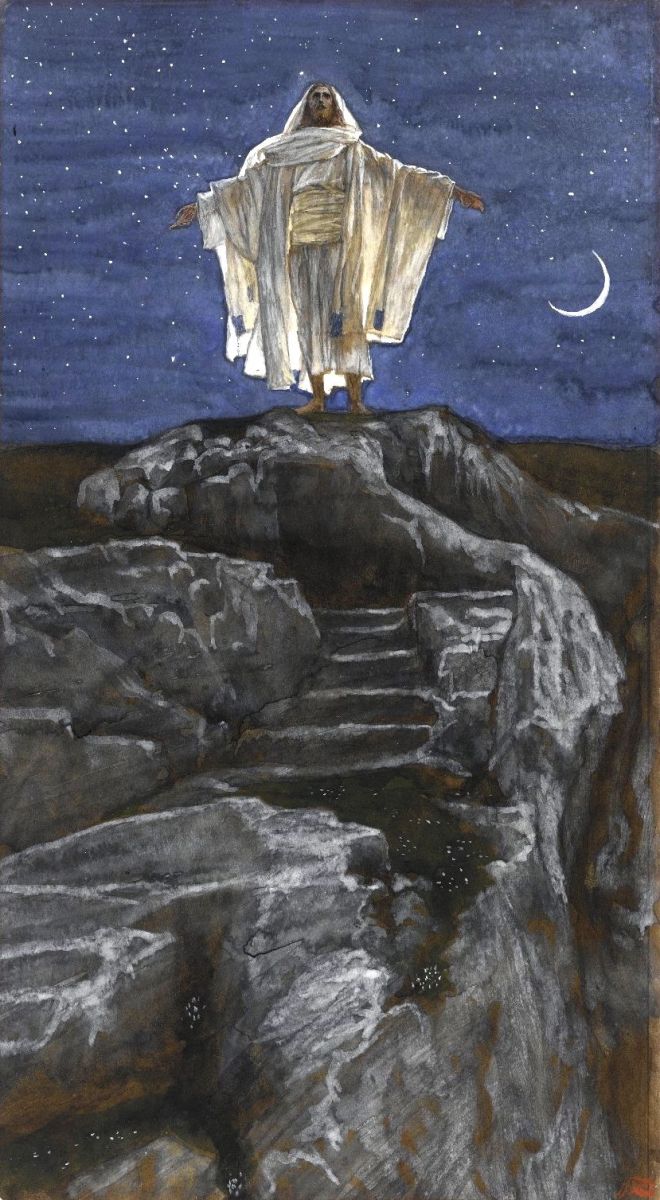Tissot, James - VM - Willem de Vink
James Tissot: Jesus Goes Up Alone onto a Mountain to Pray

The Secret of Prayer
by Willem de Vink
I am not a mountaineer, but I do have the inclination to seek out the highest point wherever I am, be it the top of an old church tower or the sky-scraping floor of a modern apartment building. It is as if up there I become less earth-bound, as if I can see further, also in my mind. Praying becomes easier. In the depth, prayer is calling out. On the heights, I am brought to silence.
I believe I can see the same urge to search out the silence in higher locations in Jesus. He went up the mountain to pray, I read in the Gospels (Matt. 14:23, Luk. 6:12, Mrk. 6:46). James Tissot captured this in a great image.
Tissot grew up in France as Jacques Tissot. He worked and had exhibitions in Paris, later in London (where he became James) and then again in Paris. During the time that many artists left romanticism behind and started experimenting with impressionism, Tissot’s work stayed more akin to the naturalism of the Pre-Raphaelites. He painted the life of the high society in Paris and London and enjoyed all the benefits of a successful artist’s life – until he started to commit himself to a strict discipline as a Christian. From 1885 onwards he devoted himself to visualizing the life of Jesus, which resulted in 350 works in eight years. After that he proceeded with the Old Testament.
To render everything as true to nature as possible, Tissot undertook study trips to Egypt, Syria and Israel (still called Palestine at the time). This means that his narrative art in watercolour and gouache gives much well-documented information. Once in a while, he surprises us with a special interpretation. The crucifixion he painted, for instance, renders events from the point of view of the crucified one. But while this painting depicts an extremely busy scene, the rendition of Jesus on the mountain is subdued. We see a mountain in which a staircase has been carved out, a sky with a crescent moon and stars, and Jesus in clothes where the moonlight shines through. The illuminated figure reminds me of a scene on another mountain where Jesus was glorified before the eyes of his disciples in equally marvellous light. However, here in this spot, his pupils were not present; the evangelists emphasize that Jesus was alone.
Looking closer, we see that the stairs do not lead to the highest point, but to the opening of a rock grave. In Israel graves were cut out of rocks and sometimes also supplied with doors and capstones, but this grave, so high up the mountain, is very unusual. The grave beneath his feet, his arms outstretched in surrender, his figure in luminous light – are we not being given a preview of Jesus’ resurrection from the dead?
Now that I think of it: it actually is the secret of prayer that we ally ourselves with something that lies in the future. With the hope that is before us. With our resurrection. It is a vista that we can only see spread out before us in prayer. Jesus preceded us in climbing the mountain that gives us that view. We should climb such a mountain more often, all by ourselves, to be with the Father and look out with him. Seek out the highest vantage point to see the furthest. In this way the glorious future that our heavenly father has in mind for us comes to us right now and we begin to shine just like Jesus in this painting.
*******
For further reading: Matthew 14:23; Matthew 17:1-9; Matthew 6:9-13; Philippians 3:20-21; Colossians 1:12-14.
James Tissot, Jesus Goes Up Alone onto a Mountain to Pray, 1886-1894, opaque watercolour over graphite on gray wove paper, 28,9 x 15,9 cm, Brooklyn Museum, New York.
Jacques Joseph Tissot (1836-1902), better known as James Tissot, was a French painter, illustrator, and caricaturist. Tissot was the son of a prosperous shopkeeper, who was a devout Roman Catholic. The young Tissot was sent away to a boarding school run by Jesuits. Tissot Senior seems to have been unenthusiastic about the prospect of his son becoming an artist, but eventually accepted the inevitability of his son's artistic pretensions forming the basis of his career. James Tissot incorporated elements of realism, early impressionism and academic art into his work. He is best known for a variety of genre paintings of contemporary European high society produced during the peak of his career, which focused on the people and women's fashion of the Belle Époque and Victorian England but would also explore many medieval, biblical, and Japoniste subjects throughout his life. His career included work as a caricaturist for Vanity Fair under the pseudonym of Coïdé.
Willem de Vink (Utrecht, b.1957) is a speaker, writer, and artist. His cartoon Jezus Messias (Jesus the Messiah) has already been published in more than 200 languages. He also wrote a book entitled Dit is liefde, Vincent, about the impact of Jesus in the life of Vincent van Gogh. He recently published the book In het hoofd van de maker, Creativiteit, Kunst, Kerk (In the Mind of the Maker, Creativity, Art, Church).
ArtWay Visual Meditation 2 July 2023


